Unit 2 - War in Children’s Lives from WW I to the Present
How does war affect children’s lives?
This gallery focuses on war and children’s lives since the beginning of World War I in 1914.
Wars have always had an enormous impact on children. Every aspect of their lives is jeopardized. Parents, particularly fathers, disappear. Friends leave, perhaps never to be seen or heard of again. Loved ones are hurt or killed. Schools are destroyed; people are chased from their homes. Everyone is terrified. For young people, wars are filled with pain and insecurity.
Over the past hundred years there have been many changes in how wars are fought. New weapons have been developed. Since the 1980s the majority of wars are civil wars so there is little separation between civilian life and the battlefield. These are two of many factors, which have had consequences for children’s experiences and participation in war life.
Since 1914 there have been many civil and regional as well as two world wars. All have caused great suffering. This gallery pays respect to this while examining the ways that children and youth have been involved in and been affected by war since the beginning of World War I. It does this through stories of individual children and youth.
This gallery focuses on war and children’s lives since the beginning of World War I in 1914.
Wars have always had an enormous impact on children. Every aspect of their lives is jeopardized. Parents, particularly fathers, disappear. Friends leave, perhaps never to be seen or heard of again. Loved ones are hurt or killed. Schools are destroyed; people are chased from their homes. Everyone is terrified. For young people, wars are filled with pain and insecurity.
Over the past hundred years there have been many changes in how wars are fought. New weapons have been developed. Since the 1980s the majority of wars are civil wars so there is little separation between civilian life and the battlefield. These are two of many factors, which have had consequences for children’s experiences and participation in war life.
Since 1914 there have been many civil and regional as well as two world wars. All have caused great suffering. This gallery pays respect to this while examining the ways that children and youth have been involved in and been affected by war since the beginning of World War I. It does this through stories of individual children and youth.
Menu
(click below to select each menu item)
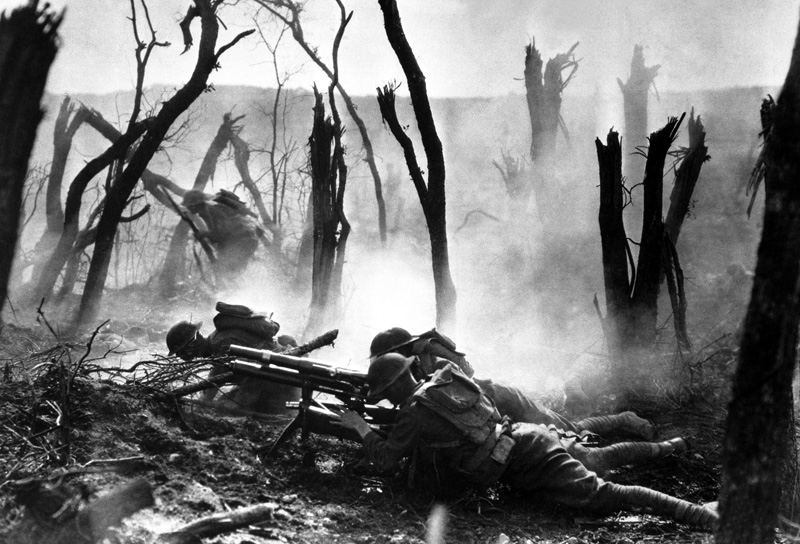
World War I: 1914 – 1918
When World War I was declared in 1914, thousands of young men rushed to the recruitment office. They were eager to be part of this great adventure.
In the early 1900s there had been a growing concern that young males were becoming “sissified”, that they lacked masculinity. War was seen as the ultimate test of manhood, a chance to demonstrate courage and strength. Teenage boys wanted to show their worth on these terms.
World War I was one of the first wars, which had a direct connection between the home front and the battlefield. Children were expected to “do their bit” through various support functions deemed appropriate for girls or boys. The common belief was that the war would be brief and the British Empire would certainly win. No one spoke of the horror of trench warfare or the deathly consequences of mustard gas. That would come later.
More...
Audio-visuals:
World War 1 in 6 Minutes (7:03) & BBC documentary on WWI Boy Soldiers (49:01)
When World War I was declared in 1914, thousands of young men rushed to the recruitment office. They were eager to be part of this great adventure.
In the early 1900s there had been a growing concern that young males were becoming “sissified”, that they lacked masculinity. War was seen as the ultimate test of manhood, a chance to demonstrate courage and strength. Teenage boys wanted to show their worth on these terms.
World War I was one of the first wars, which had a direct connection between the home front and the battlefield. Children were expected to “do their bit” through various support functions deemed appropriate for girls or boys. The common belief was that the war would be brief and the British Empire would certainly win. No one spoke of the horror of trench warfare or the deathly consequences of mustard gas. That would come later.
More...
Audio-visuals:
World War 1 in 6 Minutes (7:03) & BBC documentary on WWI Boy Soldiers (49:01)
[Back to Top]
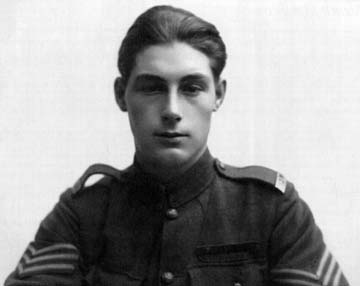
Tommy Ricketts
Tommy Ricketts was 15 years old when he joined the Royal Newfoundland Regiment in September, 1916. Like thousands of other teenage boys he lied about his age so that he would be accepted.
Tommy served from 1916 – 1918 and received the Victoria Cross for his bravery in battle. On returning home, he refused to talk about his experiences.
It is estimated that over 300,000 under-aged soldiers from the British Empire fought in WWI.
More...
Fact Sheets (PDF):
Tommy Ricketts
WW I boy soldiers
Tommy Ricketts was 15 years old when he joined the Royal Newfoundland Regiment in September, 1916. Like thousands of other teenage boys he lied about his age so that he would be accepted.
Tommy served from 1916 – 1918 and received the Victoria Cross for his bravery in battle. On returning home, he refused to talk about his experiences.
It is estimated that over 300,000 under-aged soldiers from the British Empire fought in WWI.
More...
Fact Sheets (PDF):
Tommy Ricketts
WW I boy soldiers
[Back to Top]
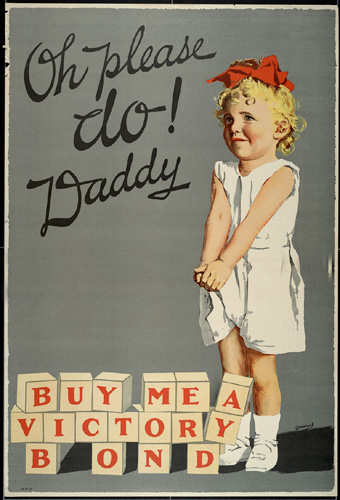
Faith Beny
Girls such as 8-year-old Faith Beny, pictured here, were often featured in wartime propaganda, including recruitment drives and fundraising.
The central message was that a man had an obligation to protect his family and country and to support the war effort. Those who failed to live up to these expectations were an embarrassment to their children.
This campaign was highly successful with $419 million being raised in two weeks.
Girls such as 8-year-old Faith Beny, pictured here, were often featured in wartime propaganda, including recruitment drives and fundraising.
The central message was that a man had an obligation to protect his family and country and to support the war effort. Those who failed to live up to these expectations were an embarrassment to their children.
This campaign was highly successful with $419 million being raised in two weeks.
More...
Slide show on use of children in wartime propaganda.
Slide show on use of children in wartime propaganda.
[Back to Top]
Norman James
Norman James proudly holds the first World War I shell to be manufactured in the Toronto munitions factory. Like the majority of Canadian youth during WW I, Norman was part of the “Home Front.”
Children were expected to “do their bit” to support Canadian soldiers fighting in Europe. Authorities maintained that this work was also an important preparation for boys’ future roles to defend their country.
More...
Fact Sheet (PDF):
Children & the Home Front (WW I)
Norman James proudly holds the first World War I shell to be manufactured in the Toronto munitions factory. Like the majority of Canadian youth during WW I, Norman was part of the “Home Front.”
Children were expected to “do their bit” to support Canadian soldiers fighting in Europe. Authorities maintained that this work was also an important preparation for boys’ future roles to defend their country.
More...
Fact Sheet (PDF):
Children & the Home Front (WW I)
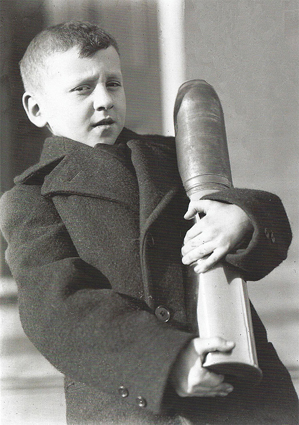
[Back to Top]

Aurora Mardiganian
Aurora was 14 years old when the Armenian Genocide began in 1915. The army entered her home village, killing most of the population, including her family. Aurora managed to escape.
After months of travelling, Aurora arrived in the United States. She quickly became a celebrity as a representative of the Armenian people. In her name, millions of dollars were raised for relief.
It is estimated that 1.5 million Armenians were killed during the Armenian Genocide which lasted from 1915 – 1923.
More...
Fact Sheets (PDF):
Aurora Mardiganian
Aremnian Genocide
Audio-visual: Beyoncé video (4:15)
Aurora was 14 years old when the Armenian Genocide began in 1915. The army entered her home village, killing most of the population, including her family. Aurora managed to escape.
After months of travelling, Aurora arrived in the United States. She quickly became a celebrity as a representative of the Armenian people. In her name, millions of dollars were raised for relief.
It is estimated that 1.5 million Armenians were killed during the Armenian Genocide which lasted from 1915 – 1923.
More...
Fact Sheets (PDF):
Aurora Mardiganian
Aremnian Genocide
Audio-visual: Beyoncé video (4:15)
[Back to Top]
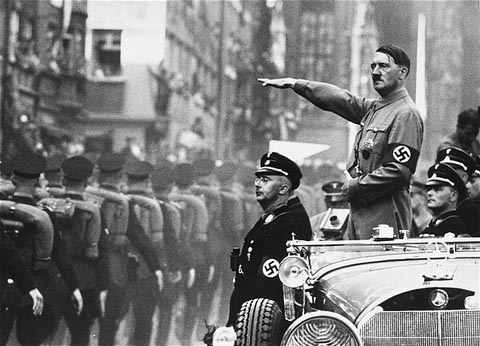
World War II: 1939 – 1945
World War II affected just about every part of the world. It was perhaps the deadliest conflict in human history with over 50 million deaths during the war’s six years.
In World War II the distinction between civilian and military life was erased. This was partly because of the bombing of civilians by both sides. But it was also because all citizens, including children, were expected to put aside personal matters and devote themselves to the war effort.
Protection of children became a major concern, particularly during the beginning of the war. Millions of young people were evacuated from their homes to increase their safety. However, as the war progressed it became impossible to keep children safe. Millions of Jewish children died in the Nazi concentration camps. As well, the use of atomic bombs on Hiroshima and Nagasaki was responsible for thousands of children’s deaths.
More...
Audio-visuals:
World War 2 in 7 Minutes (7:45) & Hitler’s Children (48:35)
World War II affected just about every part of the world. It was perhaps the deadliest conflict in human history with over 50 million deaths during the war’s six years.
In World War II the distinction between civilian and military life was erased. This was partly because of the bombing of civilians by both sides. But it was also because all citizens, including children, were expected to put aside personal matters and devote themselves to the war effort.
Protection of children became a major concern, particularly during the beginning of the war. Millions of young people were evacuated from their homes to increase their safety. However, as the war progressed it became impossible to keep children safe. Millions of Jewish children died in the Nazi concentration camps. As well, the use of atomic bombs on Hiroshima and Nagasaki was responsible for thousands of children’s deaths.
More...
Audio-visuals:
World War 2 in 7 Minutes (7:45) & Hitler’s Children (48:35)
[Back to Top]
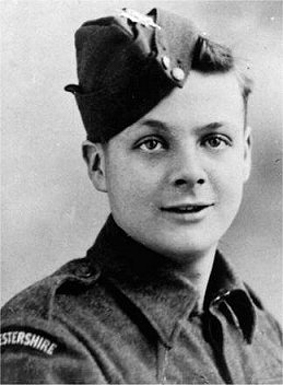
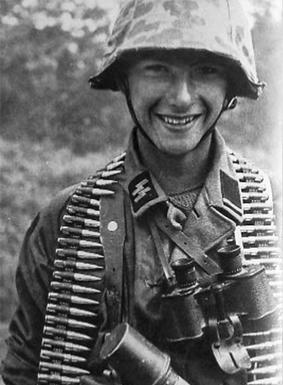
Under-aged soldiers, WW II
The boy on the left was a member of the Hitler Jugend, an organization created by Hitler to train youth, both boys and girls, into Nazi ideology. Initially young people only had support functions but towards the end of the war they were also expected to fight.
The boy on the right was an under-aged volunteer in the British Army named Bill Edwards. In recalling his time in the army, Bill stated, “It’s surprising how quickly a 17-year-old gets hardened – not indifferent, but detached. You got accustomed to wounds and death…”
More... Fact Sheets (PDF):
Hitler Youth
Bill Edwardes, British boy soldier.
Audio Visual: Hitler Youth (48:28)
The boy on the left was a member of the Hitler Jugend, an organization created by Hitler to train youth, both boys and girls, into Nazi ideology. Initially young people only had support functions but towards the end of the war they were also expected to fight.
The boy on the right was an under-aged volunteer in the British Army named Bill Edwards. In recalling his time in the army, Bill stated, “It’s surprising how quickly a 17-year-old gets hardened – not indifferent, but detached. You got accustomed to wounds and death…”
More... Fact Sheets (PDF):
Hitler Youth
Bill Edwardes, British boy soldier.
Audio Visual: Hitler Youth (48:28)
[Back to Top]
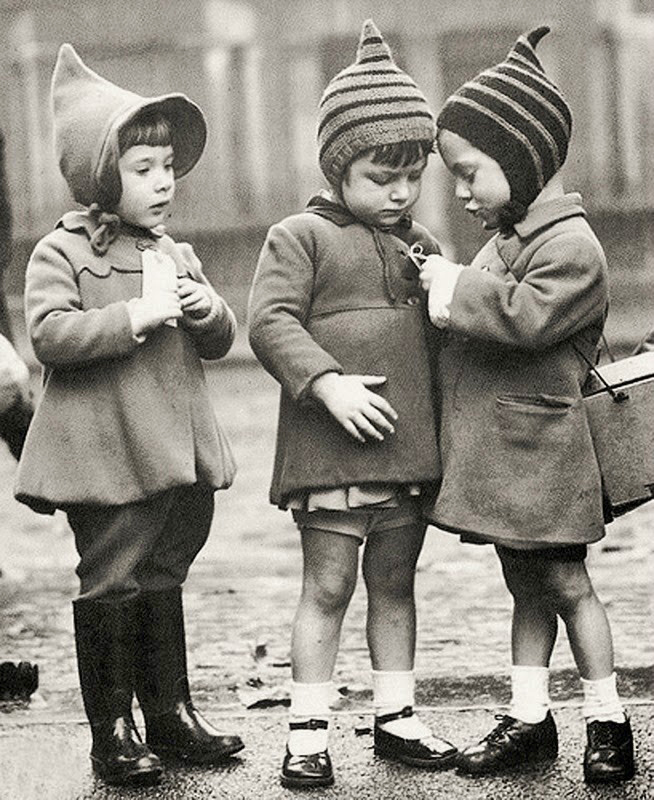
Child Evacuees, WW II
World War II directly threatened the lives of millions of children. In Nazi occupied lands Jewish children were killed or sent to concentration camps. The bombing of Great Britain cities by the German Reich jeopardized the homes and lives of thousands of children living in the cities. Strategies were developed to provide young people with greater safety.
Kinder Transport was responsible for the rescue of 10,000 Jewish children from areas under the control of the Nazi party.
Operation Pied Piper organized the evacuation of two million children from London and other British cities that were being bombed by Germany.
World War II directly threatened the lives of millions of children. In Nazi occupied lands Jewish children were killed or sent to concentration camps. The bombing of Great Britain cities by the German Reich jeopardized the homes and lives of thousands of children living in the cities. Strategies were developed to provide young people with greater safety.
Kinder Transport was responsible for the rescue of 10,000 Jewish children from areas under the control of the Nazi party.
Operation Pied Piper organized the evacuation of two million children from London and other British cities that were being bombed by Germany.
More...
Fact Sheets (PDF):
Kinder Transport
Operation Pied Piper
Audio Visuals: Operation Pied Piper: Carrie’s War (12:40) & Kinder Transport (5:05)
Fact Sheets (PDF):
Kinder Transport
Operation Pied Piper
Audio Visuals: Operation Pied Piper: Carrie’s War (12:40) & Kinder Transport (5:05)
[Back to Top]
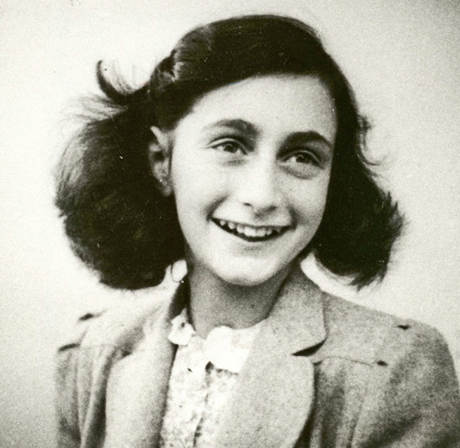
Anne Frank
The Holocaust and the extermination of the Jews was a central part of Hitler’s plan. Children were not spared.
Anne Frank and her family went into hiding in 1944. For two years she and eight others lived in a secret annex behind her father’s business in Amsterdam. Her diary recounts this time before she and the others in the annex were arrested in 1944.
Anne died of typhus in the Bergen-Belsen concentration camp in March 1945. Anne’s diary has become a voice for children of the Holocaust as well as hope for peace and forgiveness.
More...
Factsheet (PDF)
Anne Frank
The Holocaust and the extermination of the Jews was a central part of Hitler’s plan. Children were not spared.
Anne Frank and her family went into hiding in 1944. For two years she and eight others lived in a secret annex behind her father’s business in Amsterdam. Her diary recounts this time before she and the others in the annex were arrested in 1944.
Anne died of typhus in the Bergen-Belsen concentration camp in March 1945. Anne’s diary has become a voice for children of the Holocaust as well as hope for peace and forgiveness.
More...
Factsheet (PDF)
Anne Frank
Visit annefrank.org
[Back to Top]
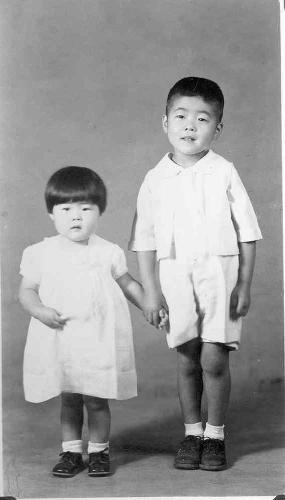
Joy Kogawa and her brother
During World War II, Canadian citizens of Japanese descent living on the British Columbia coast were suspected of being allied with Japan.
Joy Kogawa was born in Vancouver, British Colombia in 1935. When she was six years old she and her family were “evacuated” to Slocan, in the BC interior. All their property was confiscated. They were put to work in the beet fields with the other families under the Canadian government's "dispersal policy."
As an adult Joy wrote Obasan, a novel based on her experiences of internment. This book played an important role in the successful campaign for Japanese Canadians to receive a formal apology from the Canadian government. Not a single Japanese Canadian was ever found to be a traitor.
More...
Factsheet (PDF)
Joy Kogawa
Audio Visuals: Interview with Joy Kogawa (9:08) & Japanese Canadian Internment (3:38)
During World War II, Canadian citizens of Japanese descent living on the British Columbia coast were suspected of being allied with Japan.
Joy Kogawa was born in Vancouver, British Colombia in 1935. When she was six years old she and her family were “evacuated” to Slocan, in the BC interior. All their property was confiscated. They were put to work in the beet fields with the other families under the Canadian government's "dispersal policy."
As an adult Joy wrote Obasan, a novel based on her experiences of internment. This book played an important role in the successful campaign for Japanese Canadians to receive a formal apology from the Canadian government. Not a single Japanese Canadian was ever found to be a traitor.
More...
Factsheet (PDF)
Joy Kogawa
Audio Visuals: Interview with Joy Kogawa (9:08) & Japanese Canadian Internment (3:38)
[Back to Top]
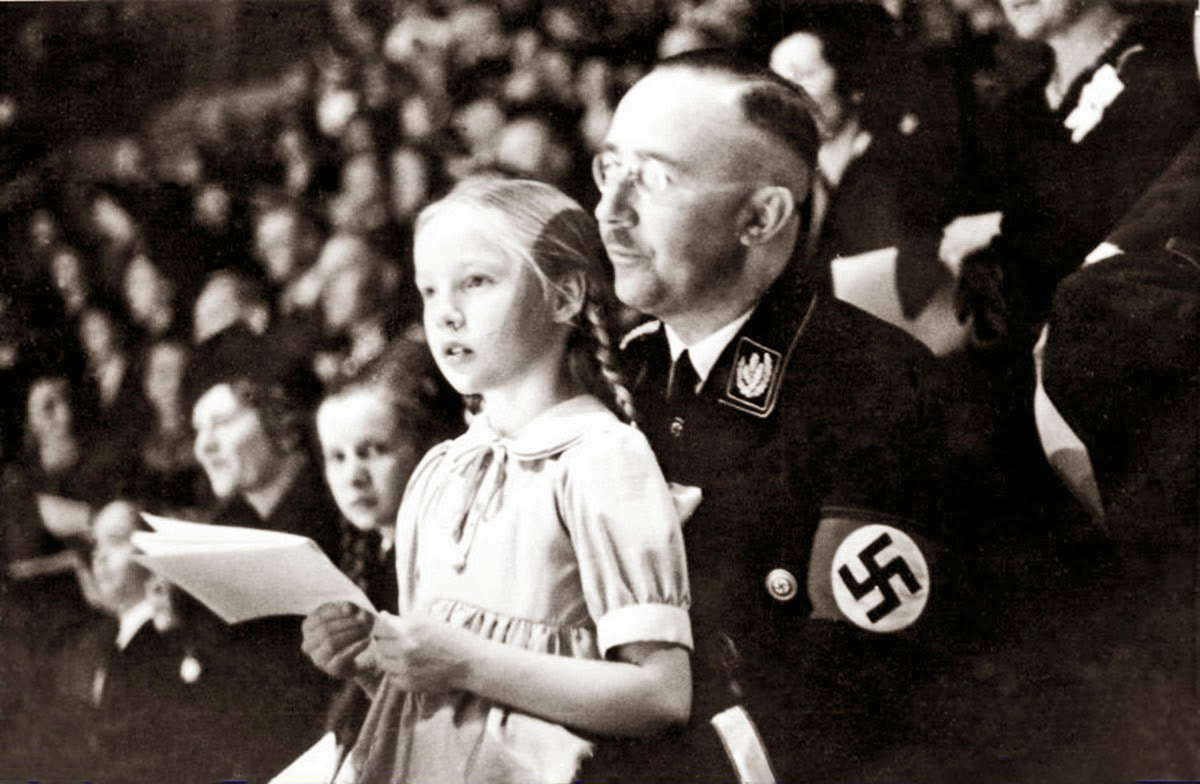
Gudrun Himmler
Gudrun was the daughter of Heinrich Himmler, the man responsible for the implementation of the “Final Solution”. This was the Nazi plan to exterminate the European Jewish population. It is estimated that over 1.5 million children were killed.
Heinrich Himmler loved his daughter dearly and spoke with her daily. He took her to visit the Dachau Concentration Camp, an experience she described as “marvellous” as she was given tea and cookies.
More...
Factsheet (PDF)
Gudrun Himmler and Nazi deniers
Gudrun was the daughter of Heinrich Himmler, the man responsible for the implementation of the “Final Solution”. This was the Nazi plan to exterminate the European Jewish population. It is estimated that over 1.5 million children were killed.
Heinrich Himmler loved his daughter dearly and spoke with her daily. He took her to visit the Dachau Concentration Camp, an experience she described as “marvellous” as she was given tea and cookies.
More...
Factsheet (PDF)
Gudrun Himmler and Nazi deniers
[Back to Top]
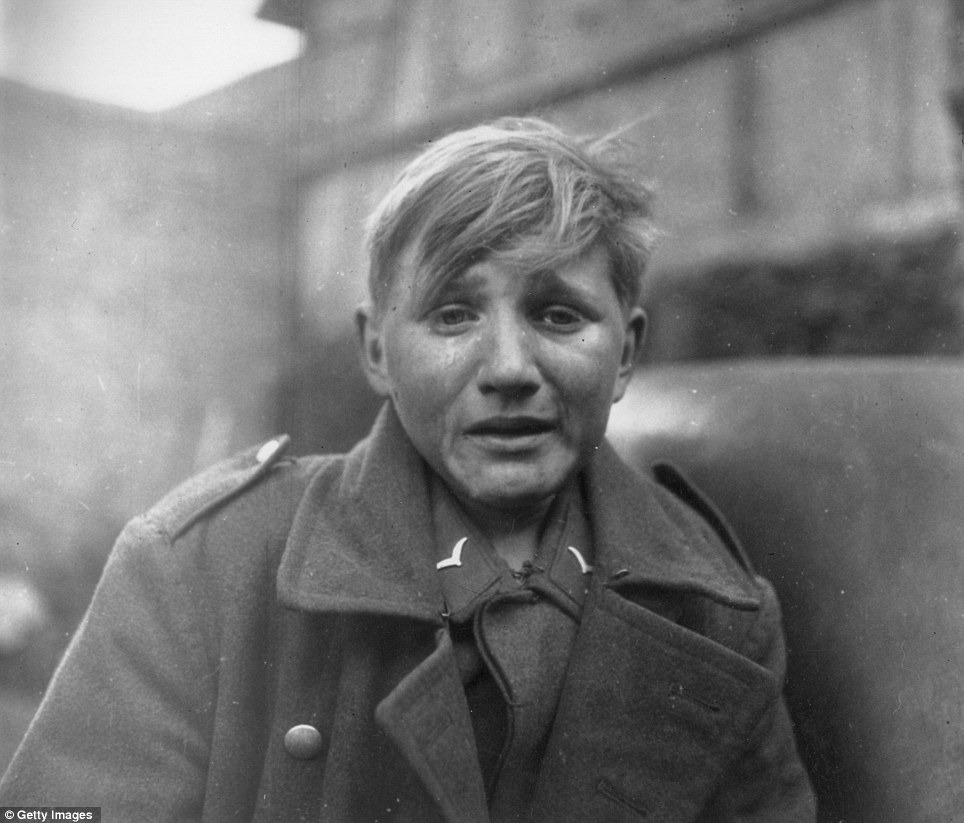
Hans-Georg Henke
This picture of Hans-George was taken shortly after he was captured by American Forces in 1945. It had been a hard day of fighting and he burst into tears while being taken prisoner.
Hans-George had joined the German Luftwaffe anti-air squad, an active fighting unit, in 1944. He was 15 years old. His father died in 1938 and his mother in 1944. He joined the Luftwaffe to support himself.
Hans-George was released and told to go home. He later reunited with his brother.
More...
Factsheet (PDF)
Hitler Youth
This picture of Hans-George was taken shortly after he was captured by American Forces in 1945. It had been a hard day of fighting and he burst into tears while being taken prisoner.
Hans-George had joined the German Luftwaffe anti-air squad, an active fighting unit, in 1944. He was 15 years old. His father died in 1938 and his mother in 1944. He joined the Luftwaffe to support himself.
Hans-George was released and told to go home. He later reunited with his brother.
More...
Factsheet (PDF)
Hitler Youth
[Back to Top]
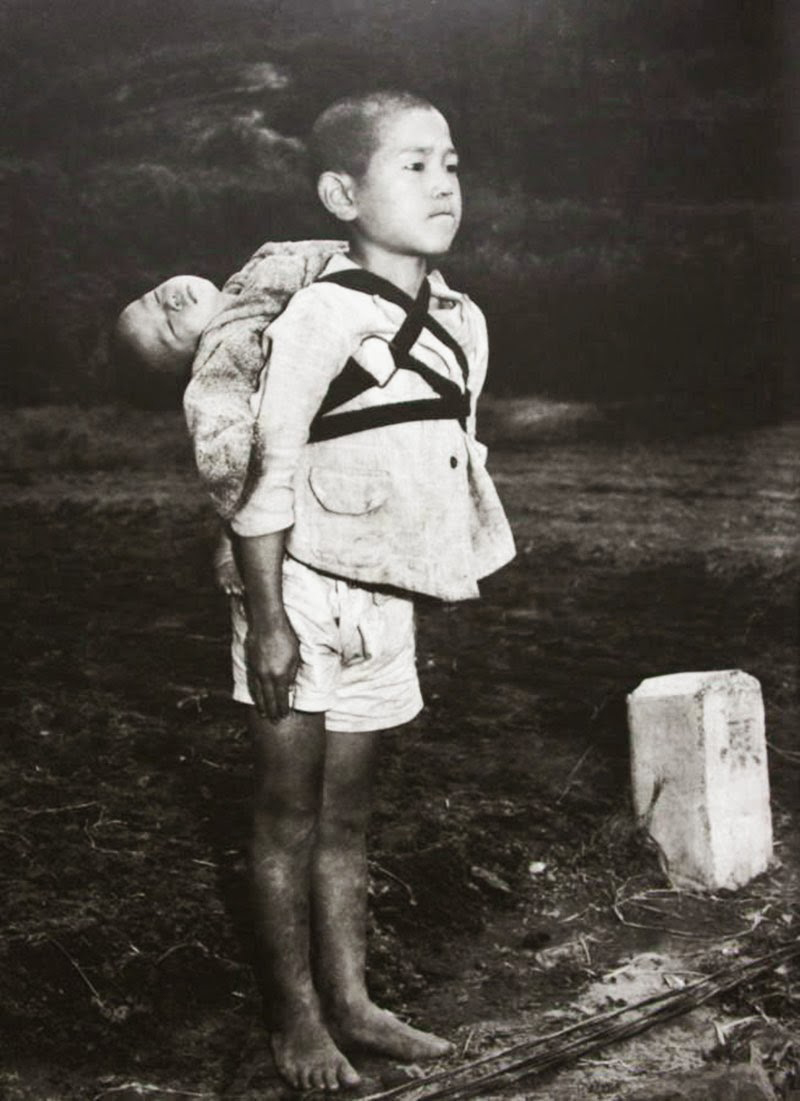
Japanese Boy carrying dead brother
In August 1945 American forces dropped atomic bombs on Hiroshima and Nagasaki, Japan. Over 100,000 people died from the effects of these bombings.
Joe O’Donnell, the photographer of the above picture, describes the scene this way: “I saw a boy about ten years old walking by. He was carrying a baby on his back. The little head was tipped back as if the baby were fast asleep. The boy stood there for five or ten minutes. The men in white masks walked over to him and quietly began to take off the rope. The men held the body and placed it on the fire. The boy stood there straight without moving. He was biting his lower lip so hard that it shone with blood.”
In August 1945 American forces dropped atomic bombs on Hiroshima and Nagasaki, Japan. Over 100,000 people died from the effects of these bombings.
Joe O’Donnell, the photographer of the above picture, describes the scene this way: “I saw a boy about ten years old walking by. He was carrying a baby on his back. The little head was tipped back as if the baby were fast asleep. The boy stood there for five or ten minutes. The men in white masks walked over to him and quietly began to take off the rope. The men held the body and placed it on the fire. The boy stood there straight without moving. He was biting his lower lip so hard that it shone with blood.”
More...
Factsheet (PDF)
Joe O’Donnell’s memory of taking the photo
Audio Visual: Hiroshima Bombing (4:36)
Factsheet (PDF)
Joe O’Donnell’s memory of taking the photo
Audio Visual: Hiroshima Bombing (4:36)
[Back to Top]
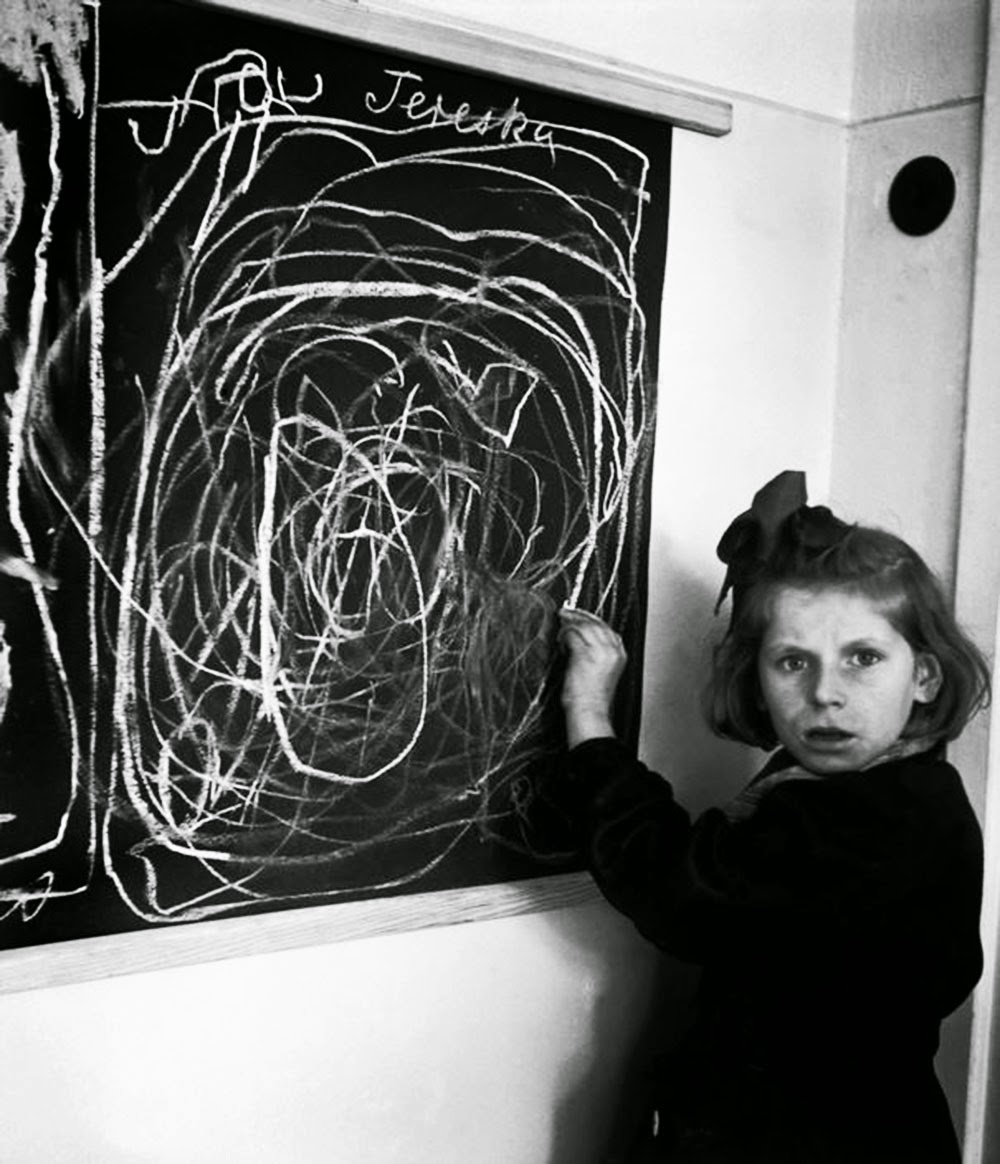
Tereszka, Concentration Camp Survivor
This photograph was taken in Warsaw, Poland in 1948 at a home for emotionally disturbed children. Tereszka was identified as a survivor of a concentration camp. It is not known how many years she lived in the camp or if she had any brothers or sisters.
She is standing next to her drawing of “home”. Tereszka was among few Polish children who survived the Holocaust. Of the 1 million Jewish children in Poland at the beginning of the war, only about 5,000 were still alive in 1945.
This photograph was taken in Warsaw, Poland in 1948 at a home for emotionally disturbed children. Tereszka was identified as a survivor of a concentration camp. It is not known how many years she lived in the camp or if she had any brothers or sisters.
She is standing next to her drawing of “home”. Tereszka was among few Polish children who survived the Holocaust. Of the 1 million Jewish children in Poland at the beginning of the war, only about 5,000 were still alive in 1945.
More...
Fact Sheet (PDF):
Tereszka and children of the holocaust
Audio Visuals: Video with Coldplay and Radiohead (5:56)
Fact Sheet (PDF):
Tereszka and children of the holocaust
Audio Visuals: Video with Coldplay and Radiohead (5:56)
[Back to Top]
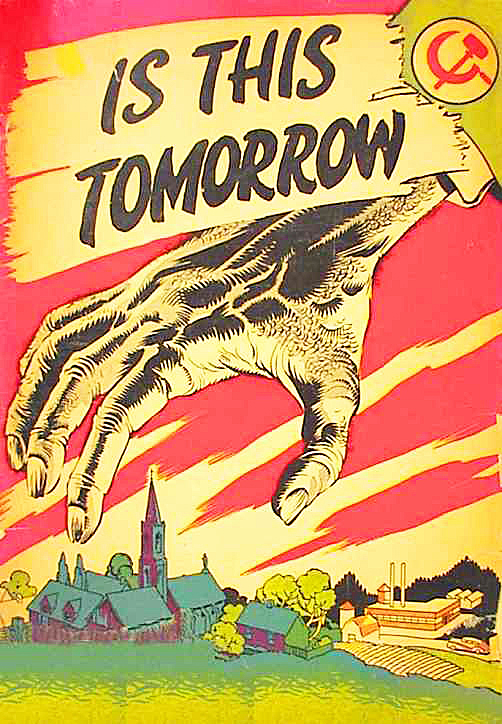
The Cold War: 1947 – 1991
Shortly after World War II ended, a new era began called “The Cold War”. The Cold War referred to political and military tension between powers in the Western Bloc, led by the United States, and the Eastern Bloc, led by the Soviet Union.
This was a war of competing ideologies: communism against capitalism. Both sides believed that they had the correct view and saw the other as evil. Both were fighting for world domination.
While the two opponents did not directly engage each other, there were many regional conflicts, known as proxy wars. The different sides in these wars usually received support from one of the super-powers, with the expectation of their loyalty to that ideology.
A major factor of the Cold war was the arms race. Both the Soviet Union and the United States had substantial arsenals of nuclear weapons and the technical ability to destroy each other. Distrust and fear of the other was at a high level.
Shortly after World War II ended, a new era began called “The Cold War”. The Cold War referred to political and military tension between powers in the Western Bloc, led by the United States, and the Eastern Bloc, led by the Soviet Union.
This was a war of competing ideologies: communism against capitalism. Both sides believed that they had the correct view and saw the other as evil. Both were fighting for world domination.
While the two opponents did not directly engage each other, there were many regional conflicts, known as proxy wars. The different sides in these wars usually received support from one of the super-powers, with the expectation of their loyalty to that ideology.
A major factor of the Cold war was the arms race. Both the Soviet Union and the United States had substantial arsenals of nuclear weapons and the technical ability to destroy each other. Distrust and fear of the other was at a high level.
More...
Audio Visual: “Cold War in 9 Minutes” (9:42)
Audio Visual: “Cold War in 9 Minutes” (9:42)
[Back to Top]
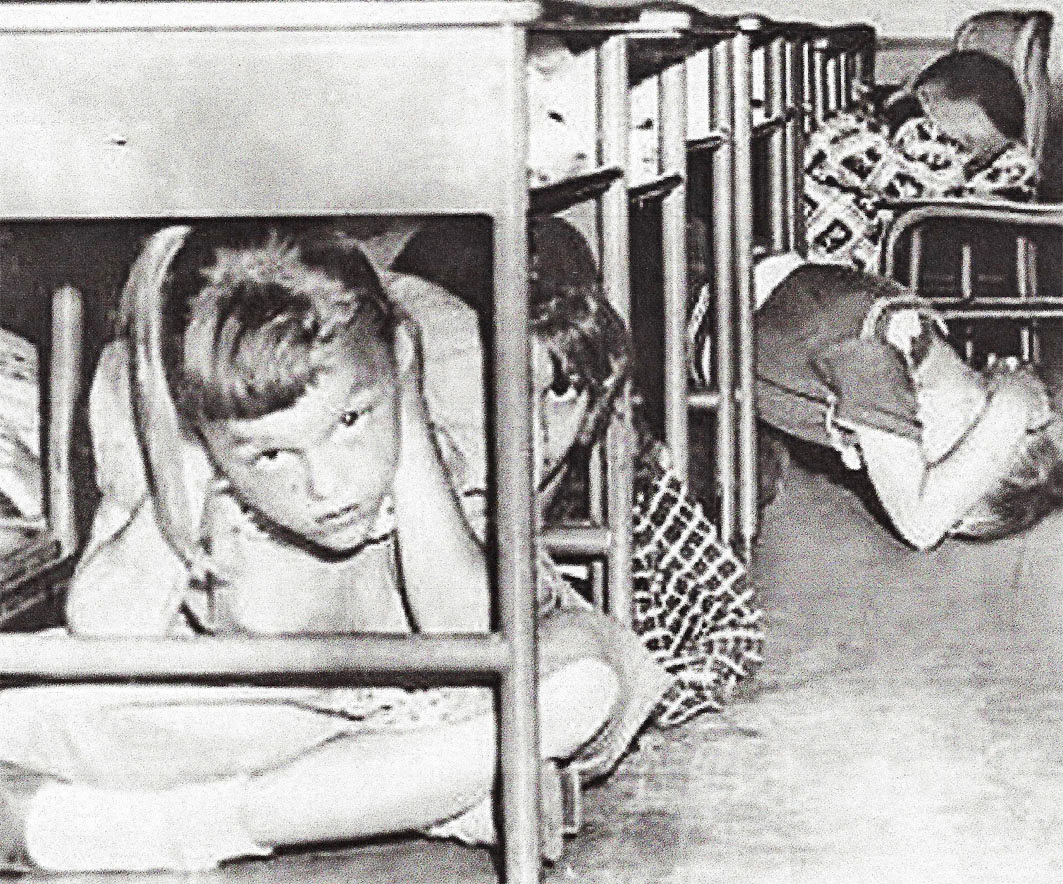
“Duck and Cover”
Thousands of young students took part in “duck and cover” drills in the 1950s.
People were terrified of a nuclear attack. Authorities said, “Not to worry”, that simply covering your head would protect a person from the light and radiation of a bomb blast. The key was to be prepared to act quickly. Children practiced jumping under their desks on their teachers’ signal.
These drills emphasized that an atomic blast could happen suddenly and anywhere. The potential for war was no longer apart from children’s lives. Instead it could enter school classrooms, city streets and playgrounds. In many ways this belief was similar to the current fear of a terrorist attack.
More...
Factsheet (PDF)
Civil Defense Movement
Audio Visuals:
-“Duck and Cover” (2:51 mins)
-Longer version of “Duck and Cover” (9:13)
-Satire: Dr. Strangelove [The War Room Scene] (3:29)
Thousands of young students took part in “duck and cover” drills in the 1950s.
People were terrified of a nuclear attack. Authorities said, “Not to worry”, that simply covering your head would protect a person from the light and radiation of a bomb blast. The key was to be prepared to act quickly. Children practiced jumping under their desks on their teachers’ signal.
These drills emphasized that an atomic blast could happen suddenly and anywhere. The potential for war was no longer apart from children’s lives. Instead it could enter school classrooms, city streets and playgrounds. In many ways this belief was similar to the current fear of a terrorist attack.
More...
Factsheet (PDF)
Civil Defense Movement
Audio Visuals:
-“Duck and Cover” (2:51 mins)
-Longer version of “Duck and Cover” (9:13)
-Satire: Dr. Strangelove [The War Room Scene] (3:29)
[Back to Top]
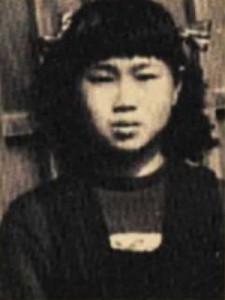
Sadako Sasaki
Sadako Sasaki was two years old when an atomic bomb was dropped on her home town of Hiroshima. Ten years later, in 1955, Sadako became sick and was diagnosed with radiation sickness.
Sadako and her friend Chizuko began to make paper cranes, following the Japanese belief that with 1,000 cranes you could have a wish granted. Sadako’s wish was for life. They made 644 cranes before Sadako died.
But Sadako has not been forgotten. Instead she has become an international symbol for peace. Each year thousands of school children make paper cranes in honour of her memory.
More...
Fact Sheet (PDF):
Sadako Saskai
Audio-visual: Sadako and the Thousand Paper Cranes (5:02)
Sadako Sasaki was two years old when an atomic bomb was dropped on her home town of Hiroshima. Ten years later, in 1955, Sadako became sick and was diagnosed with radiation sickness.
Sadako and her friend Chizuko began to make paper cranes, following the Japanese belief that with 1,000 cranes you could have a wish granted. Sadako’s wish was for life. They made 644 cranes before Sadako died.
But Sadako has not been forgotten. Instead she has become an international symbol for peace. Each year thousands of school children make paper cranes in honour of her memory.
More...
Fact Sheet (PDF):
Sadako Saskai
Audio-visual: Sadako and the Thousand Paper Cranes (5:02)
[Back to Top]
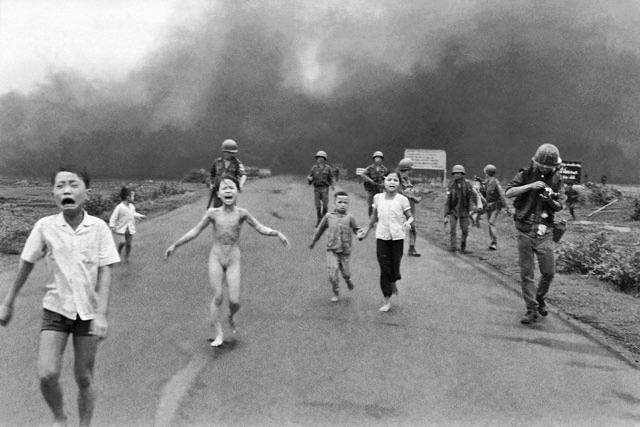
Kim Phúc
This photograph shows nine year old Kim Phúc and other children running down a road after a South Vietnamese napalm attack on their village. Kim is naked and screaming because the napalm had burned her clothes and body
This became an important photo in the campaign to ban the use of napalm as well as protests to end the Vietnam War.
As an adult Kim Phúc became a well known humanitarian. She currently lives in Canada.
More... Fact Sheet (PDF):
Kim Phúc
Audio-visual: Clip from Apocalypse Now: “I love the smell of napalm in the morning” segment. (6:14)
This photograph shows nine year old Kim Phúc and other children running down a road after a South Vietnamese napalm attack on their village. Kim is naked and screaming because the napalm had burned her clothes and body
This became an important photo in the campaign to ban the use of napalm as well as protests to end the Vietnam War.
As an adult Kim Phúc became a well known humanitarian. She currently lives in Canada.
More... Fact Sheet (PDF):
Kim Phúc
Audio-visual: Clip from Apocalypse Now: “I love the smell of napalm in the morning” segment. (6:14)
[Back to Top]
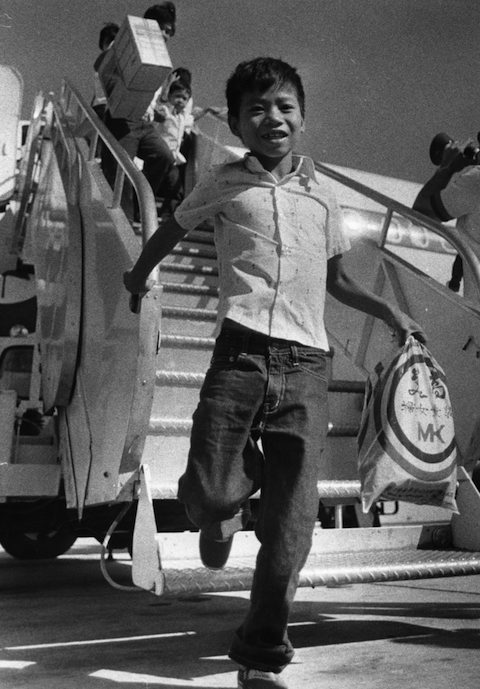
Canh Bui
It's 1982 and Canh Bui, 10 years old, is running down the airplane stairs, eager to enter Canada, his new home country. Canh and his brother were two of the over 800,000 Vietnamese “boat people” who came to Canada, Europe and the United States in search of refuge from the war.
This was a war of competing ideologies: communism against capitalism. Both sides believed that they had the correct view and saw the other as evil. Both were fighting for world domination.
Their journey to Canada was grueling: “We were at sea for 11 days. On the second day we ran into a pirate ship. [They] took all of our fuel, jewellry, and food containers. We were adrift for 9 days.”
Canh and his brother were sponsored by an Ontario family.
It's 1982 and Canh Bui, 10 years old, is running down the airplane stairs, eager to enter Canada, his new home country. Canh and his brother were two of the over 800,000 Vietnamese “boat people” who came to Canada, Europe and the United States in search of refuge from the war.
This was a war of competing ideologies: communism against capitalism. Both sides believed that they had the correct view and saw the other as evil. Both were fighting for world domination.
Their journey to Canada was grueling: “We were at sea for 11 days. On the second day we ran into a pirate ship. [They] took all of our fuel, jewellry, and food containers. We were adrift for 9 days.”
Canh and his brother were sponsored by an Ontario family.
More...
Fact Sheet (PDF):
Canh Bui
Audio-visual: Syrian refugee crisis: Lessons from Vietnamese boat people. (5:20)
Fact Sheet (PDF):
Canh Bui
Audio-visual: Syrian refugee crisis: Lessons from Vietnamese boat people. (5:20)
[Back to Top]
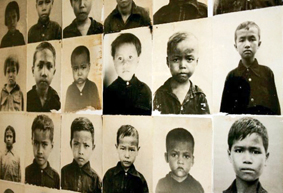
Child victims of the Cambodia Genocide: 1975 – 1979
This collage shows some of the millions of Cambodian children who were killed by the Khmer Rouge in the mid 1970s. The Khmer Rouge was committed to the creation of a classless society. All intellectuals, including their children, were seen as the enemy.
The indoctrination and training of young people was a central part of Khmer ideology. Children over eight years old were removed from their families and placed in labour camps. There they were taught that the revolution was their true parents and those not conforming to Khmer laws were corrupt enemies.
More...
Fact Sheets (PDF):
Growing Up in the Pol Pot Regime, Cambodia
Cambodia’s Next Generation
This collage shows some of the millions of Cambodian children who were killed by the Khmer Rouge in the mid 1970s. The Khmer Rouge was committed to the creation of a classless society. All intellectuals, including their children, were seen as the enemy.
The indoctrination and training of young people was a central part of Khmer ideology. Children over eight years old were removed from their families and placed in labour camps. There they were taught that the revolution was their true parents and those not conforming to Khmer laws were corrupt enemies.
More...
Fact Sheets (PDF):
Growing Up in the Pol Pot Regime, Cambodia
Cambodia’s Next Generation
[Back to Top]
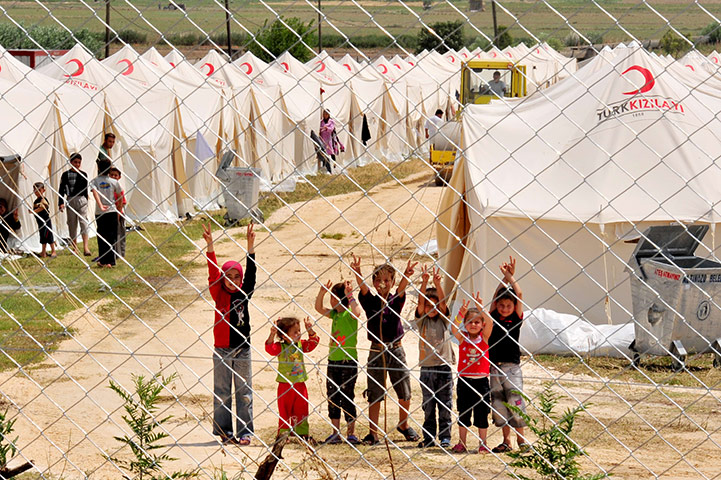
The Current Situation: 1991 – Present
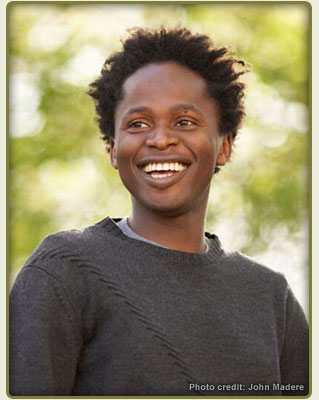
Ishmael Beah, Former child soldier
Ishmael Beah was 13 years old in 1993 when he was captured and forced to fight for the government army in Sierra Leone’s civil war. Three years later he was rescued by UNICEF. He later said that his rehabilitation was a painful experience as he had so much anger and distrust of adults.
Ishmael told his story in A Long Way Gone, a memoir which became an international bestseller and critically acclaimed publication. He went on to be a tireless advocate for children’s rights, particularly child soldiers.
More...
Factsheet (PDF)
Ishmael Beah
Audio Visuals:
-Interview with Ishmael about child soldier experience. (9:45)
-Present Day: How does ISIS recruit children? (3:12)
Ishmael Beah was 13 years old in 1993 when he was captured and forced to fight for the government army in Sierra Leone’s civil war. Three years later he was rescued by UNICEF. He later said that his rehabilitation was a painful experience as he had so much anger and distrust of adults.
Ishmael told his story in A Long Way Gone, a memoir which became an international bestseller and critically acclaimed publication. He went on to be a tireless advocate for children’s rights, particularly child soldiers.
More...
Factsheet (PDF)
Ishmael Beah
Audio Visuals:
-Interview with Ishmael about child soldier experience. (9:45)
-Present Day: How does ISIS recruit children? (3:12)
[Back to Top]
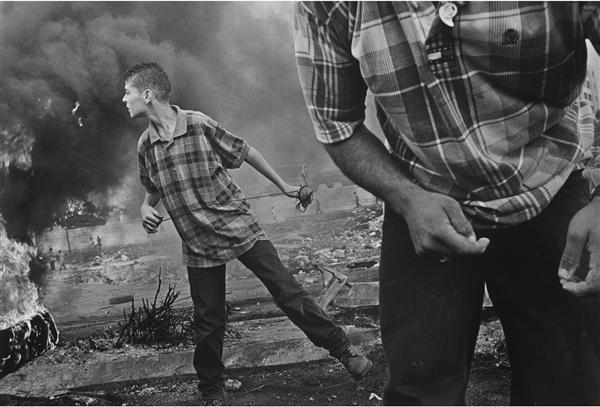
Ramallah, 2000
This photograph is of a Palestinian youth demonstration in a clash with Israeli soldiers. A boy has just thrown a stone using a home-made catapult. The photograph was taken by Larry Towell.
Palestinian youth have become increasingly involved in protests against Israel. The anger is strong, particularly for adolescent males.
More...
Fact Sheet (PDF):
Ramallah
Audio-visuals:
-Animated explanation of Israel and Palestine conflict (6:27)
-Israeli- Palestine Explained (10:02)
This photograph is of a Palestinian youth demonstration in a clash with Israeli soldiers. A boy has just thrown a stone using a home-made catapult. The photograph was taken by Larry Towell.
Palestinian youth have become increasingly involved in protests against Israel. The anger is strong, particularly for adolescent males.
More...
Fact Sheet (PDF):
Ramallah
Audio-visuals:
-Animated explanation of Israel and Palestine conflict (6:27)
-Israeli- Palestine Explained (10:02)
[Back to Top]
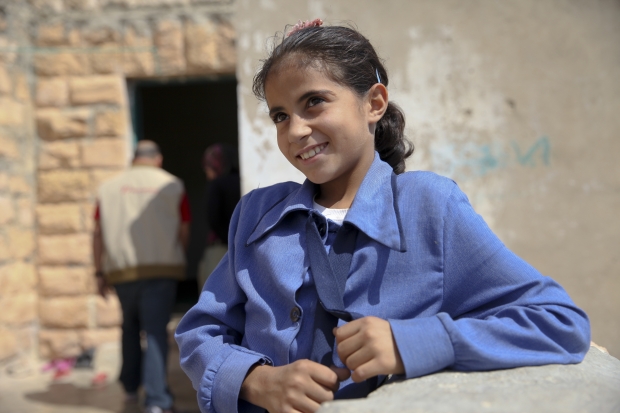
Syrian Refugee Children
Over one million Syrian children have been forced to leave their country because of the war.
With their families, many of these children have taken the dangerous journey to Europe. They are seeking a more secure life and hope that they will be able to return to school.
The girl above is one of several Syrian youth who did artwork and writing to describe their experiences as refugees.
More...
Factsheet (PDF)
Drawings and writing by Syrian children
Over one million Syrian children have been forced to leave their country because of the war.
With their families, many of these children have taken the dangerous journey to Europe. They are seeking a more secure life and hope that they will be able to return to school.
The girl above is one of several Syrian youth who did artwork and writing to describe their experiences as refugees.
More...
Factsheet (PDF)
Drawings and writing by Syrian children
[Back to Top]
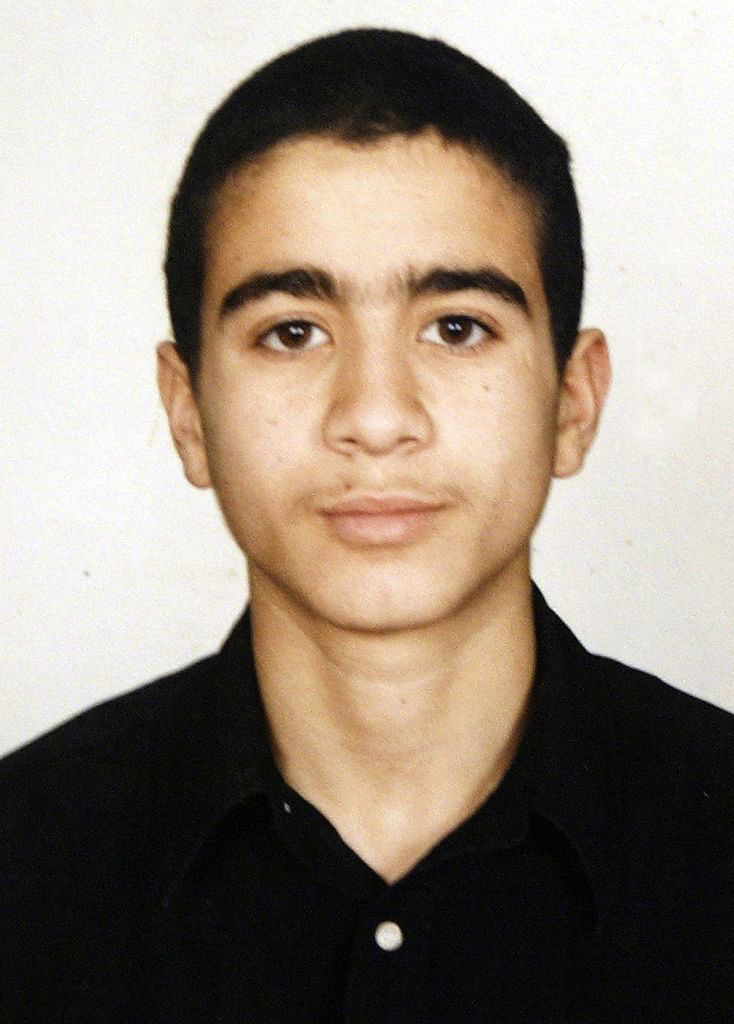
Omar Ahmed Algredr Khadr
Omar Khadr was born in Toronto, Canada in 1986. As a teenager he was taken to Afghanistan by his father who was a member of an extreme religious group. Though the details are not confirmed, it seems that Omar was pressed into combat service by his father.
Omar was charged with throwing a grenade during a battle that resulted in the death of an American soldier. He was taken prisoner by the Americans and shipped to Guantanamo Bay where he was held for 10 years. During this time he was subjected to intense questioning by both American and Canadian officials.
Omar’s case received world-wide attention as he was the first under aged soldier since World War II to be prosecuted for war crimes. His conviction and sentence (eight years) were widely denounced by civil rights groups and various newspaper editorials. In September 2012 Omar was repatriated to Canada and was released on bail in May, 2015, pending an appeal of his U.S conviction.
More...
Visit this website for more information.
Omar Khadr was born in Toronto, Canada in 1986. As a teenager he was taken to Afghanistan by his father who was a member of an extreme religious group. Though the details are not confirmed, it seems that Omar was pressed into combat service by his father.
Omar was charged with throwing a grenade during a battle that resulted in the death of an American soldier. He was taken prisoner by the Americans and shipped to Guantanamo Bay where he was held for 10 years. During this time he was subjected to intense questioning by both American and Canadian officials.
Omar’s case received world-wide attention as he was the first under aged soldier since World War II to be prosecuted for war crimes. His conviction and sentence (eight years) were widely denounced by civil rights groups and various newspaper editorials. In September 2012 Omar was repatriated to Canada and was released on bail in May, 2015, pending an appeal of his U.S conviction.
More...
Visit this website for more information.
[Back to Top]
Photo Credits
We gratefully acknowledge the sources for the following images which have been included in this gallery. All these images were obtained in the public domain, through the Internet. This website is to be used for educational purposes only. An effort has been made to contact and inform the appropriate sources and we apologize to any that we have missed.
The sources for the images are listed in this PDF.
We gratefully acknowledge the sources for the following images which have been included in this gallery. All these images were obtained in the public domain, through the Internet. This website is to be used for educational purposes only. An effort has been made to contact and inform the appropriate sources and we apologize to any that we have missed.
The sources for the images are listed in this PDF.










